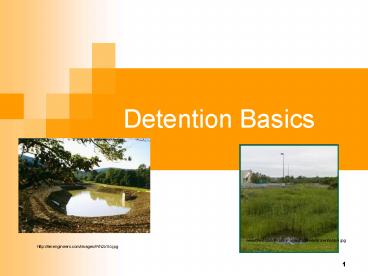Detention Basics - PowerPoint PPT Presentation
1 / 39
Title:
Detention Basics
Description:
... Spillway Typical Design Criteria Spillway crest set at or above the maximum impoundment elev Designed for emergency spillway design storm ... – PowerPoint PPT presentation
Number of Views:140
Avg rating:3.0/5.0
Title: Detention Basics
1
Detention Basics
www.b-e-c.com/PromoPages/GatewayBrownfields4.jpg
http//emengineers.com/images/Wh2o1lo.jpg
2
Objectives
- Know what a detention basin is
- Know how to develop an inflow hydrograph
- Know how to determine a stage-storage curve
- Know how to determine an outflow curve
3
/www.dfo-mpo.gc.ca/canwaters-eauxcan/infocentre/gu
idelines-conseils/factsheets-feuillets/nfld/images
/fact17_e/4-7.jpg
4
Detention Basin-Purposes
- Store water temporarily during a storm and
release the stored water slowly - Attenuate the flow
- Store first-flush
- Design for infiltration
- If all water is infiltrated then (retention
basin)
5
Detention Basins
- On-Site
- Regional
6
Detention Basins
- Inflow (ditch or pipe)
- Storage
- Outflow (single/multiple stage
- Orifice
- Weir
- Emergency spillway
7
Routing
- Method used to model the outflow hydrograph
- Based on continuity equation
- Water in varies
- Water out varies
8
Information Needed to Route
- Inflow hydrograph
- Relation of storage volume to elevation in the
proposed detention basin - Relation of outflow to water level elevation
(discharge rating)
9
Inflow hydrograph
- Ch 5 of TR-55 (NRCS method)
- Modified rational method (see book 11.2)
- Simple symmetrical triangle (2tc)
- Asymmetrical triangle (total base 2.67 tc)
10
TR-55 Hydrograph(NRCS Method)
Peak flow is higher after development Peak flow
occurs earlier after development
11
Rational MethodSimple Symmetrical Triangle
12
Rational MethodTime base of 2.67 tc
Area under hydrograph?
13
Computing Storage Volumes
- Two Methods
- Elevation-Area (detention basins)
- Average End-Area (pipes)
14
Computing Storage Volumes
- Elevation-Area (detention basins)
- Contour lines are determined around basin
- Determine area of each contour
- Volume between 2 contours average areadepth
between the contours - Prepare a table showing elevation, area,
incremental volume and cumulative volume - See example 14-1 (page 341)
14
15
Elevation-Area Method Ex 14-1
Elev (ft) Area (ft2) Incr. Vol (ft3) Cum. Vol (ft3)
230 0 0 0
231 250 (250/21)125 125
232 840 ((250840)/21) 545 670
233 1350 1095 1765
234 2280 1815 3580
235 3680 2980 6560
236 5040 4360 10,920
16
(No Transcript)
17
Computing Storage Volumes
- Average end-area (pipes)
- Find u/s area at elevation increments
- Find d/s area at elevation increments
- Average the areas multiply by length
- This gives you total volumes (not incremental
volumes) - See Example 14-2 (page 343)
18
End Area Method
19
Pipe Detention Basin
20
Discharge Rating
- Calculate outflows based on water elevation in
the detention pond - Orifice and weir equations are used
- Single stage (see pg 345)
- Two stage (see page 348)
- If more than one stage, calculate each outlet
separately and add to get stage-discharge curves
21
Orifices
- Hole in a wall through which water flows
- Square edge
- Beveled edge
21
22
Orifice
- When water flows through an orifice the water
contracts with a smaller area than the original
orifice opening (vena contracta)
www.spiraxsarco.com
www.diracdelta.co.uk
22
23
General Orifice Equation
- Qca(2gh).5
- Where
- Qdischarge (cfs or cms)
- cdischarge coefficient (0.62 often used)
- across-sectional orifice area (sq ft or sq
meters) - htotal head (ft or m)
- ggravitational constant (32.2 or 9.81)
23
24
Orifice Discharge
- Free Discharge
- Submerged Discharge
- Equation is the same. Head for the submerged
discharge is the difference between upper and
lower water surfaces
24
25
Orifice-Free Discharge
- Given Dia6, WSE220.0 ft
- Elev of orifice centerline200.0 ft
- Qca(2gh).5
- Q0.620.196(232.220).5
- Q4.4 cfs
25
26
Weir
- Horizontal surface over which water is allowed to
flow - Used to regulate and measure flows
http//www.flow3d.com/appl/weir.htm
26
27
Rectangular, Sharp-Crested Weir
- QcLH3/2
- Q-flow (cfs)
- c-adjusted discharge coefficient (careful)
- c3.270.4(H/P) where P is ht of weir above
channel bottom - L-effective crest length, ft
- LL-0.1nH
- Lactual measured crest length and n of
contractions - H-head above crest, ft
27
28
Rectangular, Broad-Crested Weir
- QcLH3/2
- Q-flow (cfs)
- c-discharge coefficient (App A-5 English units)
- L-crest length, ft
- H-head above crest, ft
28
29
V-Notch or Triangular Weir
- Qctan(angle/2)H5/2
- c 2.5 (but should calibrate)
29
30
Other Weir Types
- Cipoletti (trapezoidal)
- Ogee (dam spillway)
youngiil.co.kr
www.lmnoeng.com
30
31
Detention Outlet Structures
- Single Stage (culvert or orifice)
- Multi-Staged to handle different flows
- Combination of orifices /or weirs
31
32
Single Stage Outlet Example (Ex14-3)
- An outlet consisting of a 12 pipe is proposed
for a detention basin. The invert of the pipe is
320.0 feet and the top of berm is 325.0 ft.
Compute the discharge rating for the outlet. - Area0.785 sq ft
- Assume c0.62
- Use orifice equation Qca(2gh).5
32
33
Single Stage Outlet Example
WSE (ft) h (to c/l of pipe) Q out (cfs)
320 0 0
321 0.5 2.8
322 1.5 4.8
323 2.5 6.2
324 3.5 7.3
325 4.5 8.3
33
34
34
35
Multi-Stage Outlet Example 14-4 (pg 349)
- 4 Orifice and 2 weirs L1.5 and L12.5
35
36
Multistage Outlet
36
37
37
38
Emergency Spillway
- Emergency Outlet
- Rainfall exceeds design storm
- Outlet becomes blocked
- Purpose
- Prevent overtopping of berm
- Control direction of overflow
39
Emergency Spillway Typical Design Criteria
- Spillway crest set at or above the maximum
impoundment elev - Designed for emergency spillway design storm
(minus what can be handled by outflow structure)
or designed to convey peak discharge of design
storm (assuming outflow structure plugged) - Top of berm WSE through the spillway
freeboard (1-2 typical)































